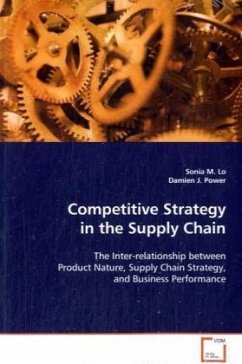
Competitive Strategy in the Supply Chain
The Inter-relationship between Product Nature, Supply Chain Strategy, and Business Performance
Versandkostenfrei!
Versandfertig in 6-10 Tagen
52,99 €
inkl. MwSt.

PAYBACK Punkte
26 °P sammeln!
As market globalization and technological change accelerate, competition between firms has migrated from a focus on the individual firm to networks of firms operating as trading partners within a chain of supply. As a result of this trend the traditional way of determining a strategy within a firm has come into question. The concept of supply chain strategy has consequently been developed. This book reviews the role of product demand characteristics (using Fisher s (1997) four-cell model as the framework) in the determination of supply chain strategy, and the subsequent impact on firm performa...
As market globalization and technological change
accelerate, competition between firms has migrated
from a focus on the individual firm to networks of
firms operating as trading partners within a chain
of supply. As a result of this trend the traditional
way of determining a strategy within a firm has come
into question. The concept of supply chain strategy
has consequently been developed. This book reviews
the role of product demand characteristics (using
Fisher s (1997) four-cell model as the framework) in
the determination of supply chain strategy, and the
subsequent impact on firm performance. This book
sheds new light on the determination of an
appropriate supply chain strategy that will be of
value to both academic researchers and management
practitioners alike. In particular, the potential
power of developing hybrid strategies that are
responsive to the changing dynamics of the
marketplace is highlighted.
accelerate, competition between firms has migrated
from a focus on the individual firm to networks of
firms operating as trading partners within a chain
of supply. As a result of this trend the traditional
way of determining a strategy within a firm has come
into question. The concept of supply chain strategy
has consequently been developed. This book reviews
the role of product demand characteristics (using
Fisher s (1997) four-cell model as the framework) in
the determination of supply chain strategy, and the
subsequent impact on firm performance. This book
sheds new light on the determination of an
appropriate supply chain strategy that will be of
value to both academic researchers and management
practitioners alike. In particular, the potential
power of developing hybrid strategies that are
responsive to the changing dynamics of the
marketplace is highlighted.












